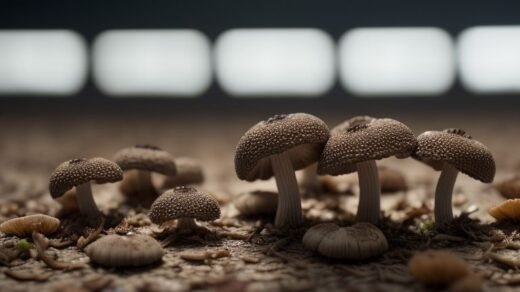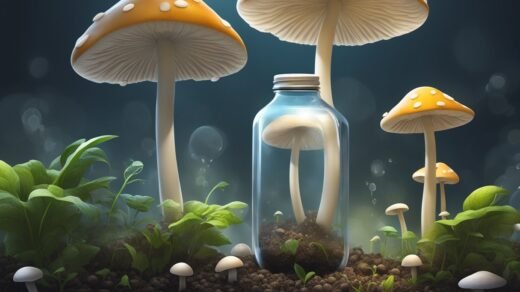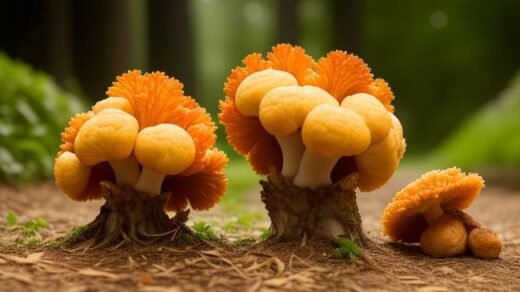Chanterelle mushrooms are a highly sought-after delicacy in the culinary world due to their unique flavor and texture. These mushrooms are known for their trumpet-shaped caps and bright yellow-orange color. While they can be found in the wild, growing your own chanterelle mushrooms can be a rewarding and sustainable way to enjoy this delicious fungus.
To grow chanterelle mushrooms, it is important to create the ideal growing conditions. Chanterelles thrive in cool, moist environments with plenty of organic matter, such as decaying wood or leaf litter. Shaded areas with these characteristics are ideal for cultivating chanterelle mushrooms. It is also important to choose the right kind of trees to grow your mushrooms on, as chanterelles have a symbiotic relationship with certain tree species.
Once you have created the ideal growing conditions, it is important to be patient. Chanterelles can take several months to a few years to establish and produce mushrooms. It is also important to maintain consistent moisture levels, as chanterelles prefer a humid environment. With the right conditions and some patience, growing your own chanterelle mushrooms can be a rewarding and sustainable way to enjoy this delicious delicacy.
Understanding Chanterelle Mushrooms

Species Identification
Chanterelle mushrooms are a type of fungi that belong to the genus Cantharellus. They are known for their distinctive trumpet-like shape and bright yellow-orange color. Chanterelles have a fruity and slightly peppery flavor, making them a popular ingredient in many dishes.
There are several different species of chanterelle mushrooms, each with its own unique characteristics. The most common species found in North America is Cantharellus cibarius, also known as the golden chanterelle. Other species include the black trumpet chanterelle (Craterellus cornucopioides) and the white chanterelle (Cantharellus subalbidus).
Habitat Preferences
Chanterelle mushrooms are found in a variety of habitats, including deciduous and coniferous forests, as well as grasslands and meadows. They tend to grow in clusters and are often found near the base of trees, particularly oak, beech, and pine trees.
Chanterelles prefer moist soil and are typically found in areas with high humidity levels. They are most commonly found in the late summer and fall, although some species may fruit as early as spring.
When growing chanterelle mushrooms, it is important to mimic their natural habitat as closely as possible. This may involve introducing suitable tree saplings to the growing area and ensuring that the soil conditions are optimal. It is also important to be patient, as chanterelles can take several months to establish and produce mushrooms.
Cultivation Requirements

Substrate Preparation
Chanterelle mushrooms grow best in soil that is moist, well-draining, and rich in organic matter. It is recommended to use a substrate mixture that includes hardwood sawdust, wheat bran, and gypsum. The sawdust should be sterilized before use to prevent contamination by other fungi or bacteria.
To prepare the substrate, mix the sawdust, wheat bran, and gypsum in a ratio of 5:3:1. Add water to the mixture until it reaches a moisture content of 60-65%. Pack the substrate into plastic bags or jars and sterilize it in a pressure cooker or autoclave at 15 psi for 90 minutes.
After sterilization, the substrate should be allowed to cool to room temperature before inoculation with chanterelle spawn. The spawn can be purchased from a reputable supplier or obtained by collecting wild chanterelle mushrooms and using them to inoculate the substrate.
Temperature and Humidity Control
Temperature and humidity are critical factors in chanterelle mushroom cultivation. The optimal temperature range for their growth is between 55-65°F (13-18°C). Maintaining a consistent and moderate temperature is crucial for their development. Too much heat or cold can hinder their growth.
Humidity should be kept at around 85-90% during the vegetative growth phase and reduced to 70-80% during the fruiting phase. This can be achieved by misting the substrate with water or using a humidifier.
It is also important to monitor the carbon dioxide (CO2) levels in the growing environment. High levels of CO2 can inhibit mushroom growth and reduce yields. Adequate ventilation should be provided to maintain CO2 levels below 1000 ppm.
By following these substrate preparation and temperature and humidity control guidelines, growers can successfully cultivate chanterelle mushrooms and enjoy their unique flavor and texture.
Inoculation and Colonization
Spawn Selection
Before beginning the inoculation process, it is important to select the right spawn for your chanterelle mushrooms. Spawn is the term used to describe the material that has been colonized by the mycelium of the mushroom. There are many types of spawn available, including sawdust, grain, and liquid culture.
Sawdust spawn is the most commonly used type of spawn for chanterelle mushrooms. It is made by mixing sawdust with the mycelium of the mushroom and then allowing it to colonize. Grain spawn is another option, and it is made by mixing grain with the mycelium. Liquid culture spawn is the least commonly used type of spawn, but it can be useful for starting new cultures.
When selecting spawn, it is important to choose a strain that is well-suited to your growing conditions. Some strains are better suited to cooler temperatures, while others thrive in warmer environments. Additionally, some strains are more resistant to pests and diseases than others.
Inoculation Techniques
Once you have selected your spawn, it is time to begin the inoculation process. Inoculation is the process of introducing the spawn to the substrate, which is the material that the mushrooms will grow on.
There are several techniques for inoculating chanterelle mushrooms, including:
- Grain Spawn Method: This method involves mixing the grain spawn with the substrate and then incubating it until the mycelium has colonized the substrate.
- Sawdust Spawn Method: This method involves mixing the sawdust spawn with the substrate and then incubating it until the mycelium has colonized the substrate.
- Liquid Culture Method: This method involves injecting the liquid culture into the substrate and then incubating it until the mycelium has colonized the substrate.
Regardless of the method you choose, it is important to maintain sterile conditions throughout the inoculation process to prevent contamination. This can be achieved by using a laminar flow hood or a still air box.
Once the substrate has been inoculated, it will take several weeks for the mycelium to fully colonize the substrate. During this time, it is important to maintain the proper temperature and humidity levels to ensure optimal growth.
Maintenance and Monitoring
Watering Practices
Maintaining proper moisture levels is essential for the growth of chanterelle mushrooms. The soil should be kept moist at all times, but not waterlogged. Overwatering can lead to the growth of competing fungi, which can harm or kill the chanterelle mycelium.
To ensure proper watering practices, it is recommended to use a spray bottle or a watering can with a fine nozzle to gently mist the soil. This will help prevent the soil from becoming too wet and will also help to prevent the spread of contamination.
Contamination Prevention
Contamination is one of the biggest threats to the growth of chanterelle mushrooms. It is important to maintain a clean growing environment to prevent the growth of competing fungi, bacteria, or other contaminants.
To prevent contamination, it is recommended to use sterile equipment and to maintain a clean and sanitized growing area. This includes regularly wiping down surfaces with a disinfectant and washing hands thoroughly before handling the mushrooms or any of the growing equipment.
In addition, it is important to monitor the growing area regularly for any signs of contamination, such as mold growth or unusual odors. If contamination is detected, it is important to take immediate action to prevent it from spreading. This may include removing contaminated soil or equipment, or even starting over with a new batch of mushrooms.
By following proper watering practices and taking steps to prevent contamination, growers can help ensure the healthy growth of their chanterelle mushrooms.
Harvesting and Storage
Harvesting Techniques
When it comes to harvesting chanterelle mushrooms, it is important to use proper techniques to ensure the best possible yield. Here are some tips to follow:
- Gently twist the mushroom at the base to detach it from the soil, rather than pulling it out forcefully. This helps to prevent damage to the mycelium and allows for regrowth in the future.
- Use a sharp knife to cut the mushroom at the base if it is too difficult to twist off.
- Harvest only mature mushrooms that are fully developed and have a golden-yellow color. Immature mushrooms should be left to grow and develop further.
- Avoid harvesting mushrooms that are too old or have started to decay. They will not be as flavorful and may even be harmful to consume.
Post-Harvest Handling
After harvesting, it is important to handle the chanterelle mushrooms carefully to maintain their quality and flavor. Here are some tips for post-harvest handling:
- Remove any dirt or debris from the mushrooms by gently brushing them with a soft-bristled brush or wiping them with a damp cloth. Avoid washing them with water, as this can cause them to become waterlogged and lose their flavor.
- Store the mushrooms in a paper bag or a container with a paper towel to absorb any excess moisture. Do not store them in a plastic bag, as this can cause them to become slimy and spoil more quickly.
- Store the mushrooms in the refrigerator for up to five days, or freeze them for longer storage. To freeze, simply clean and slice the mushrooms, then spread them out on a baking sheet and freeze until solid. Once frozen, transfer them to a freezer-safe container or bag and store in the freezer for up to six months.
By following these harvesting and storage techniques, you can enjoy the delicious flavor of chanterelle mushrooms for longer periods.




